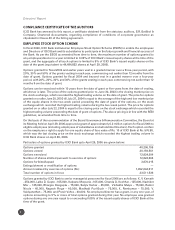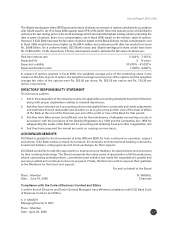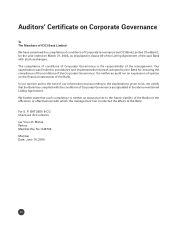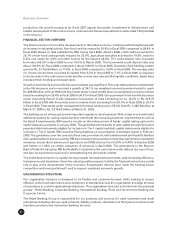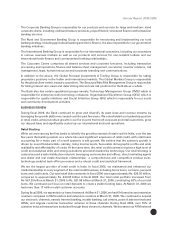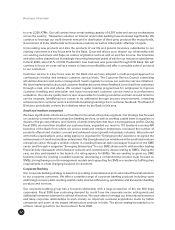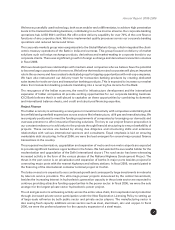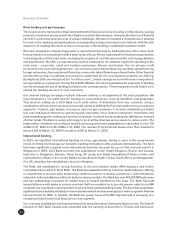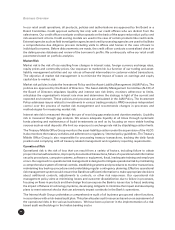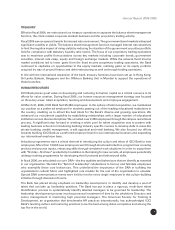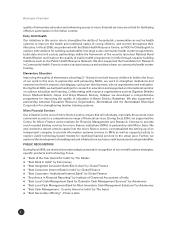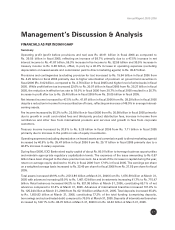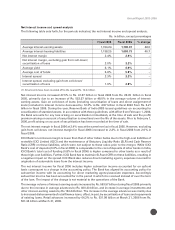ICICI Bank 2006 Annual Report Download - page 37
Download and view the complete annual report
Please find page 37 of the 2006 ICICI Bank annual report below. You can navigate through the pages in the report by either clicking on the pages listed below, or by using the keyword search tool below to find specific information within the annual report.
36
Business Overview
In our retail credit operations, all products, policies and authorisations are approved by the Board or a
Board Committee. Credit approval authority lies only with our credit officers who are distinct from the
sales teams. Our credit officers evaluate credit proposals on the basis of the approved product policy and
risk assessment criteria. Credit scoring models are used in the case of certain products like credit cards.
External agencies such as field investigation agencies and credit processing agencies are used to facilitate
a comprehensive due diligence process including visits to offices and homes in the case of loans to
individual borrowers. Before disbursements are made, the credit officer conducts a centralised check on
the delinquencies database and review of the borrower’s profile. We continuously refine our retail credit
parameters based on portfolio analytics.
Market Risk
Market risk is the risk of loss resulting from changes in interest rates, foreign currency exchange rates,
equity prices and commodity prices. Our exposure to market risk is a function of our trading and asset-
liability management activities and our role as a financial intermediary in customer-related transactions.
The objective of market risk management is to minimise the impact of losses on earnings and equity
capital due to market risk.
Market risk policies include the Investment Policy and the Asset-Liability Management (ALM) Policy. The
policies are approved by the Board of Directors. The Asset-Liability Management Committee (ALCO) of
the Board of Directors stipulates liquidity and interest rate risk limits, monitors adherence to limits,
articulates the organisation’s interest rate view and determines the strategy in light of the current and
expected environment. These policies and processes are articulated in the ALM Policy. The Investment
Policy addresses issues related to investments in various trading products. RMG exercises independent
control over the process of market risk management and recommends changes in processes and
methodologies for measuring market risk.
Interest rate risk is measured through the use of re-pricing gap analysis and duration analysis. Liquidity
risk is measured through gap analysis. We ensure adequate liquidity at all times through systematic
funds planning and maintenance of liquid investments as well as by focusing on more stable funding
sources such as retail deposits. We limit our exposure to exchange rate risk by stipulating position limits.
The Treasury Middle Office Group monitors the asset-liability position under the supervision of the ALCO.
It also monitors the treasury activities and adherence to regulatory / internal policy guidelines. The Treasury
Middle Office Group is also responsible for processing treasury transactions, tracking the daily funds
position and complying with all treasury-related management and regulatory reporting requirements.
Operational Risk
Operational risk is the risk of loss that can result from a variety of factors, including failure to obtain
proper internal authorisations, improperly documented transactions, failure of operational and information
security procedures, computer systems, software or equipment, fraud, inadequate training and employee
errors. Our approach to operational risk management is designed to mitigate operational risk by maintaining
a comprehensive system of internal controls, establishing systems and procedures to monitor transactions,
maintaining key back-up procedures and undertaking regular contingency planning. Effective operational
risk management system would ensure that Bank has sufficient information to make appropriate decisions
about additional controls, adjustments to controls, or other risk responses. Our operational risk
management policy aims at minimising losses and customer dissatisfaction due to failure in processes,
focusing on flaws in products and their design that can expose the Bank to losses due to fraud, analysing
the impact of failures in technology/systems, developing mitigants to minimise the impact and developing
plans to meet external shocks that can adversely impact continuity in the Bank’s operations.
The Internal Audit Group undertakes a comprehensive audit of all business groups and other functions,
in accordance with a risk-based audit plan. This plan allocates audit resources based on an assessment of
the operational risks in the various businesses. We have been a pioneer in the implementation of a risk-
based audit methodology in the Indian banking sector.


